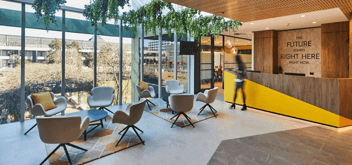Corporate offices today face numerous challenges in adapting to the changing work landscape. Key Issues include;
- Choosing the right working model - mandatory five-day office attendance or flexible schedules? Each choice affects productivity, morale, and retention.
- Underused office spaces are costly- what space is essential in this hybrid work era?
- Remote work impacts culture - complicating staff bonding and collaboration.
- The right mix of activity-based work areas - Teams often feel detached from workplace design, not understanding its purpose.
These challenges highlight the need for a strategic workplace approach—aligning the environment with business goals, employee needs, and growth. A strong workplace strategy helps companies support collaboration, culture, and efficiency while adapting to uncertainties. This article explores key steps to develop a strategy that integrates physical space, policy, and technology for a cohesive, productive environment.
How a Workplace Strategy Can Help
A workplace strategy supports your business’s overall strategy and goals. By fusing the two from the very beginning, you can ensure they remain aligned through office relocations, refurbishments and for business as usual too.
A good design is based on hard data and observations about how people work, and it aims to create a workplace that will support the business’s goals and strategy long into the future, as the business grows and evolves.
A workplace strategy demands a significant amount of analysis, study and expertise. Some of the common areas to explore are office space utilisation and employee data, office design, facilities management and planning for the company’s future (considerations that may be missed if you jump to your office fitout requirements without a strategy in place).
But all of this research and data isn’t just to make your space look great, it has further implications—a clever and skilful workplace strategy:
- Prepares your business for external uncertainty through forecasting
- Identifies the best ways of working to improve efficiency and productivity, ultimately improving revenue and profitability
- Produces a plan and framework for smart organisation change
- Attracts talent and keeps existing staff happy by delivering a stable and well thought out work environment
- Supports broader business objectives and goals
The Key Steps to Developing a Workplace Strategy
Now that you know the benefits of a workplace strategy, let’s look at developing a strategy for your new office space. Some things to consider initially:
- Physical space
The most obvious place to start is the actual physical space of the office. We’re talking about the different environments employees use to do their work – desks, breakout areas, offices, meeting rooms etc. Consider the furniture and how the office fixtures are laid out. How do these support your employees in their work?
- Policy
As with any change, workplace strategy implementation will be met with resistance from some parts or people in the business. Backing up the reasons for implementation with your employees with internal policies around communication, behavioural change and training will support a smooth transition.
- Workplace technology
As workplaces evolve with remote working becoming more popular and activity-based working being more widely adopted, technology is increasingly being used to ensure an effective and agile workplace. Consider how technology can aid your employees to work in their optimal style and how this process can be made as seamless as possible.
Keeping these things in mind, let’s jump into the steps to developing a workplace design strategy:
1. Audit your current work environment
Whether you are planning on an office relocation, a refurbishment or simply a refresh, it’s important to start with an audit of the current situation. Without solid data, any plans or strategy you put in place will be assumption and guesswork. A workplace audit will arm you with data to make informed decisions based on an understanding of workplace needs and wants across your employees of all levels.
Things to include in your workplace audit:
- The nature of work
- Where they work
- The hours people work
- The blend of work activities (collaboration, meetings, phone calls, private work etc.)
- The technology required to support the work
- Storage requirements and how technology should be implemented to go paper lite
- Any support services required
2. Understand how space is currently being used
An audit is a good place to start to understand how your office space is currently being used. But you’ll also want to talk with employees to identify trends in their needs and wants and compare these against best practice in workplace design.
A survey is an important tool to build an understanding of how the workplace is changing, growing and how employees’ patterns of work are shifting in your business. A survey can also give you insights over the dominant types of work activities in your business, and consequently the amount and type of workspace which should be dedicated to different kinds of activities.
3. Get input from a variety of people in the business
When you’re surveying employees ensure you are getting feedback from all levels of the business. Beyond surveying, it’s also a good idea to arrange personal interviews and/or workshops with a selection of employees in different roles, departments and with varying levels of responsibility.
Interviews, surveys and workshops can help you to understand the needs and desires of individuals, teams and departments. Remember, these activities are all about listening and gathering data. You can then use this information to analyse trends and make informed decisions in your workplace strategy.
4. Consider the future
A workplace strategy shouldn’t only be focussed on the current workplace situation, it should also look to the future of the business. With an ever-competitive market, many workplaces are turning to innovative and technologically advanced workplaces to attract talent and support their employees. With this in mind consider how you can support new work trends by asking these questions:
- How is the business going to evolve in the next 3, 5 and 10 years?
- What activities do employees currently undertake that won’t be required in the future?
- How will the way employees work evolve?
- How can collaboration be enhanced with more remote workers entering the mix?
- What are the options to improve workstation utilisation given new ways of working?
5. Select the right workplace technology
While it’s getting hard to keep up with technology, innovation through workplace design will look to the future and embed technology solutions that help employees work as efficiently as possible. It’s important not to get caught up in the ‘latest and greatest’ but to evaluate each tool, develop a clear understanding of the benefits it can provide and figure out if it will give you a good return on investment. Start with identifying what issues you are solving/supporting through technology, then analyse what technologies are available to solve and support the need.
Ask these questions:
- Will this technology increase efficiency and productivity?
- Does this technology align with our business goals and objectives?
- Is this technology the best tool for the job?
- Are there alternatives to consider?
- How can ROI be measured?
6. Consider costs
As with any business strategy implementation, costs need to be taken into consideration. The project budget is set in the early strategy session with the executives. Make sure there is detailed and continuously monitored budgeting to ensure costs are being controlled across the complete process of your workplace strategy being executed.
Conclusion
Each company is unique, and crafting a comprehensive workplace strategy that tailors design decisions to fit specific work styles and models can be an intricate endeavor. Engaging an expert workplace strategist often proves invaluable, ensuring your business makes informed and impactful permanent changes.
Find out more here:







